stop start FIAT 500L 2018 Owner handbook (in English)
[x] Cancel search | Manufacturer: FIAT, Model Year: 2018, Model line: 500L, Model: FIAT 500L 2018Pages: 268, PDF Size: 4.87 MB
Page 55 of 268

Warning light What it means
ENGINE COOLANT TEMPERATURE TOO HIGH
The warning light turns on when the engine is overheated. On some versions the display shows the
dedicated message.
In normal driving conditions: stop the car, switch off the engine and check that the water level in the
reservoir is not below the MIN mark. In this case, wait for the engine to cool down, then slowly and
carefully open the cap, top up with coolant and check that the level is between the MIN and MAX marks on
the reservoir itself. Also check visually for any fluid leaks. If, when restarting, the warning light (or display
symbol) switches on again, contact a Fiat Dealership.
If the car is used under demanding conditions (e.g. in high-performance driving):slow down and, if
the warning light stays on, stop the car. Wait for 2 or 3 minutes with the engine running and slightly
accelerated to further favour the coolant circulation. Then stop the engine. Check that the coolant level is
correct as described above.
IMPORTANT On demanding routes, it is advisable to keep the engine on and slightly accelerated for a few
minutes before stopping it.
53
Page 56 of 268
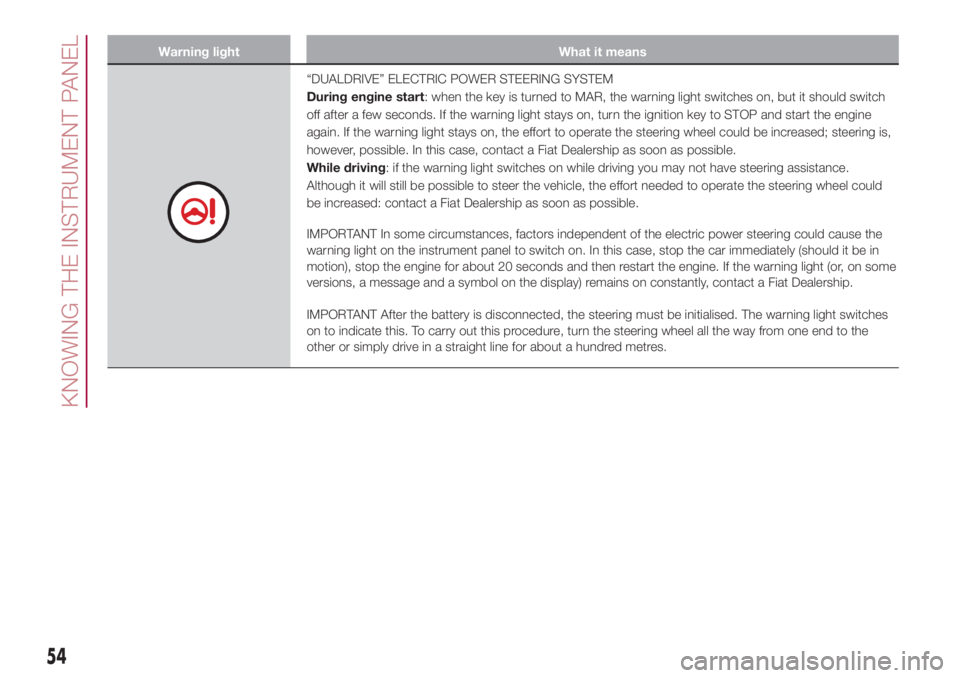
Warning light What it means
“DUALDRIVE” ELECTRIC POWER STEERING SYSTEM
During engine start: when the key is turned to MAR, the warning light switches on, but it should switch
off after a few seconds. If the warning light stays on, turn the ignition key to STOP and start the engine
again. If the warning light stays on, the effort to operate the steering wheel could be increased; steering is,
however, possible. In this case, contact a Fiat Dealership as soon as possible.
While driving: if the warning light switches on while driving you may not have steering assistance.
Although it will still be possible to steer the vehicle, the effort needed to operate the steering wheel could
be increased: contact a Fiat Dealership as soon as possible.
IMPORTANT In some circumstances, factors independent of the electric power steering could cause the
warning light on the instrument panel to switch on. In this case, stop the car immediately (should it be in
motion), stop the engine for about 20 seconds and then restart the engine. If the warning light (or, on some
versions, a message and a symbol on the display) remains on constantly, contact a Fiat Dealership.
IMPORTANT After the battery is disconnected, the steering must be initialised. The warning light switches
on to indicate this. To carry out this procedure, turn the steering wheel all the way from one end to the
other or simply drive in a straight line for about a hundred metres.
54
KNOWING THE INSTRUMENT PANEL
Page 62 of 268

Green warning lights
Warning light What it means
PETROL OPERATION (LPG or Natural Power versions)
The warning light comes on if the LPG (LPG versions) or methane (Natural Power versions) runs out. In
these cases the system automatically switches to petrol operation. On some versions, a specific message
is shown on the display.
SIDE LIGHTS AND DIPPED BEAM HEADLIGHTS/FOLLOW ME HOME
The warning light switches on when the side lights or dipped headlights are turned on.
Follow me home: the light comes on when this device is active. The display shows the duration (in
seconds) set for the function.
FOG LIGHTS
The warning light comes on when the front fog lights are turned on.
LEFT DIRECTION INDICATOR
The warning light switches on when the direction indicator control stalk is moved downwards or, together
with the right direction indicator, when the hazard warning light button is pressed.
RIGHT DIRECTION INDICATOR
The warning light switches on when the direction indicator control stalk is moved upwards or, together with
the left direction indicator, when the hazard warning light button is pressed.
AUTOMATIC ENGINE STOP (versions with Start&Stop system)
The warning light switches on when the engine is automatically stopped by the Start&Stop system.
60
KNOWING THE INSTRUMENT PANEL
Page 69 of 268
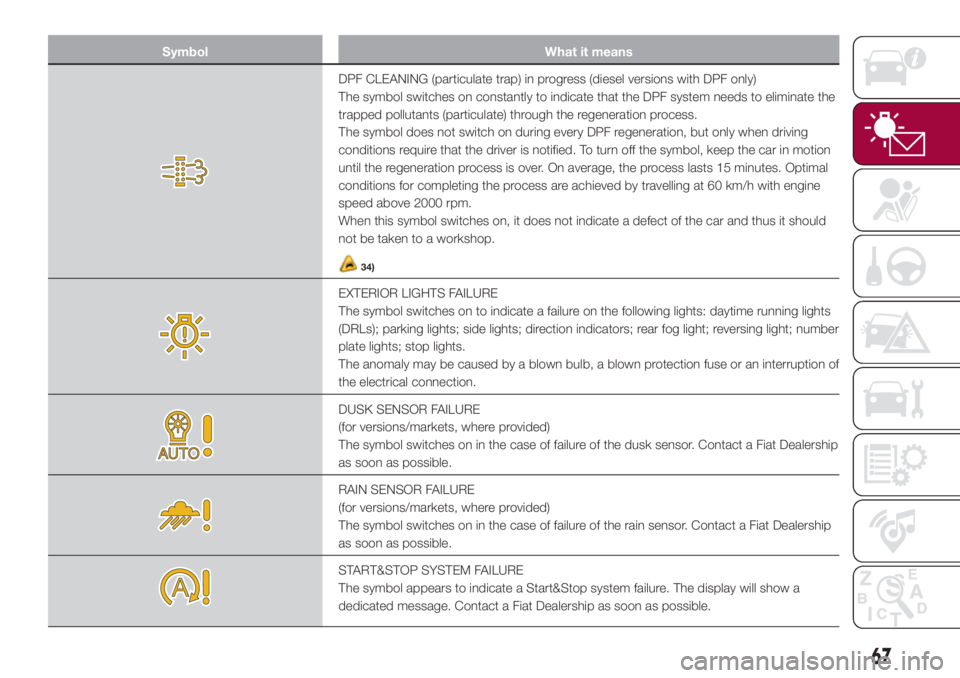
Symbol What it means
DPF CLEANING (particulate trap) in progress (diesel versions with DPF only)
The symbol switches on constantly to indicate that the DPF system needs to eliminate the
trapped pollutants (particulate) through the regeneration process.
The symbol does not switch on during every DPF regeneration, but only when driving
conditions require that the driver is notified. To turn off the symbol, keep the car in motion
until the regeneration process is over. On average, the process lasts 15 minutes. Optimal
conditions for completing the process are achieved by travelling at 60 km/h with engine
speed above 2000 rpm.
When this symbol switches on, it does not indicate a defect of the car and thus it should
not be taken to a workshop.
34)
EXTERIOR LIGHTS FAILURE
The symbol switches on to indicate a failure on the following lights: daytime running lights
(DRLs); parking lights; side lights; direction indicators; rear fog light; reversing light; number
plate lights; stop lights.
The anomaly may be caused by a blown bulb, a blown protection fuse or an interruption of
the electrical connection.
DUSK SENSOR FAILURE
(for versions/markets, where provided)
The symbol switches on in the case of failure of the dusk sensor. Contact a Fiat Dealership
as soon as possible.
RAIN SENSOR FAILURE
(for versions/markets, where provided)
The symbol switches on in the case of failure of the rain sensor. Contact a Fiat Dealership
as soon as possible.
START&STOP SYSTEM FAILURE
The symbol appears to indicate a Start&Stop system failure. The display will show a
dedicated message. Contact a Fiat Dealership as soon as possible.
67
Page 70 of 268
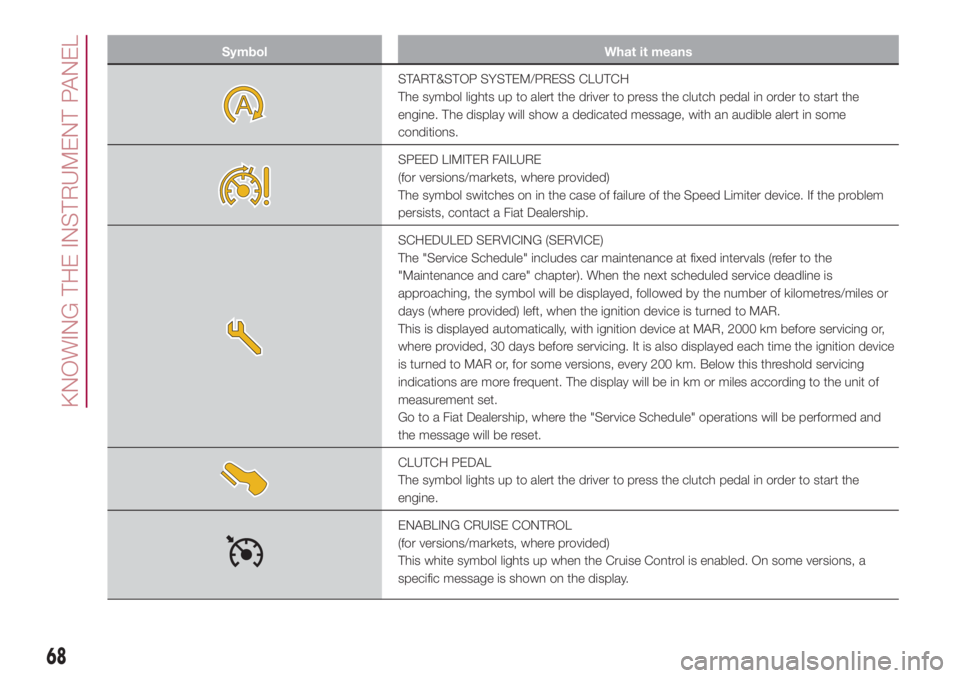
Symbol What it means
START&STOP SYSTEM/PRESS CLUTCH
The symbol lights up to alert the driver to press the clutch pedal in order to start the
engine. The display will show a dedicated message, with an audible alert in some
conditions.
SPEED LIMITER FAILURE
(for versions/markets, where provided)
The symbol switches on in the case of failure of the Speed Limiter device. If the problem
persists, contact a Fiat Dealership.
SCHEDULED SERVICING (SERVICE)
The "Service Schedule" includes car maintenance at fixed intervals (refer to the
"Maintenance and care" chapter). When the next scheduled service deadline is
approaching, the symbol will be displayed, followed by the number of kilometres/miles or
days (where provided) left, when the ignition device is turned to MAR.
This is displayed automatically, with ignition device at MAR, 2000 km before servicing or,
where provided, 30 days before servicing. It is also displayed each time the ignition device
is turned to MAR or, for some versions, every 200 km. Below this threshold servicing
indications are more frequent. The display will be in km or miles according to the unit of
measurement set.
Go to a Fiat Dealership, where the "Service Schedule" operations will be performed and
the message will be reset.
CLUTCH PEDAL
The symbol lights up to alert the driver to press the clutch pedal in order to start the
engine.
ENABLING CRUISE CONTROL
(for versions/markets, where provided)
This white symbol lights up when the Cruise Control is enabled. On some versions, a
specific message is shown on the display.
68
KNOWING THE INSTRUMENT PANEL
Page 75 of 268

ACTIVE SAFETY
SYSTEMS
The car has the following active safety
systems:
ABS (Anti-lock Braking System);
ESC (Electronic Stability Control)
system;
HH (Hill Holder) system;
ASR (AntiSlip Regulation) system;
DST (Dynamic Steering Torque
or steering corrector) system;
ERM (Electronic Rollover Mitigation)
system.
ABS (Anti-lock Braking
System)
43) 44) 45) 46) 47) 48) 49)
This system, which is an integral part of
the braking system, prevents one or
more wheels from locking and slipping
in all road surface conditions,
irrespective of the intensity of the
braking action, ensuring that the car
can be controlled even during
emergency braking and optimising
stopping distances.
The ABS also integrates the following
systems: EBD (Electronic Braking Force
Distribution), MSR (Motor
Schleppmoment Regelung) and HBA
(Hydraulic Brake Assist).IMPORTANT To obtain the maximum
efficiency of the braking system, a
bedding-in period of about 500 km is
needed: during this period it is better to
avoid sharp, repeated and prolonged
braking.
50) 51) 52)
System intervention
A slight pulsing of the brake pedal and
noise indicates the intervention of the
ABS: this is completely normal when
the system intervenes.
ESC (Electronic Stability
Control) SYSTEM
53) 54) 55) 56) 57) 58)
The ESC system corrects the car’s
understeer and oversteer, distributing
the brake force on the wheels
appropriately. The torque supplied by
the engine can also be reduced in order
to maintain control of the car.
System intervention
The intervention of the system is
indicated by the flashing of the
warning light on the instrument
panel, to inform the driver that the car is
in critical stability and grip conditions.Switching the system on
The ESC system switches on
automatically when the engine is
started and cannot be switched off.
GRAVITY CONTROL
(for versions/markets, where provided)
63)
It is an integral part of the ESC system
and is aimed at keeping the car at a
constant speed during a descent,
operating autonomously on the brakes
in various ways at the same time.
In this way, the “Gravity Control”
function assists the drive on steep
gradients in low-grip conditions and/or
on rough terrain.
For more information on system
operation, see the “Driving assistance
systems” paragraph in this chapter.
73
Page 78 of 268

DRIVING
ASSISTANCE
SYSTEMS
The car can feature the following driving
assistance systems:
City Brake Control - “Collision
Mitigation” system
iTPMS
For the operation of the systems, see
the following pages.
CITY BRAKE CONTROL -
“Collision Mitigation”
SYSTEM
(for versions/markets, where provided)
64) 65) 66) 67) 68)
35) 36) 37) 38) 39) 40) 41) 42)
This is a driving assistance system,
which includes a laser sensor, located
in the upper part of the windscreen
fig. 64, that can detect the presence of
nearby cars in front of the car.
In the event of an imminent collision the
system intervenes by automatically
braking to prevent the impact or
mitigate its effects.The system is only active if:
the ignition key is turned to
MAR;
the car speed is between 5 and
30 km/h;
a forward gear is engaged;
the front seat belts are fastened;
the “Mode Selector” device is
in “Normal” mode.
Engagement/disengagement
The system can be deactivated (and
reactivated) using the display setup
menu (see the "Display" paragraph in
the "Knowing the instrument panel"
chapter).
Operation
The system intervenes if there is risk of
imminent collision and the driver does
not press the brake pedal promptly.If the system detects that the vehicle
ahead could be hit, it may prepare the
vehicle to a possible emergency
braking.
If the driver does not carry out any
action to prevent the collision, the
system may automatically slow down
the vehicle, in order to prepare it to
a possible impact.
When there is risk of impact, if the
action on the brake pedal by the driver
is not sufficient, the system may
intervene in order to improve
the reaction of the braking system,
therefore reducing vehicle speed
further.
When driving uphill on slopes with
major changes of gradient, the system
may intervene, activating the braking
system.
Versions equipped with Start&Stop
system: at the end of the automatic
braking, the Start&Stop system will
activate as described in the "Start&Stop
system" paragraph of the "Starting
and driving" chapter.
Versions equipped with manual
transmission: at the end of the
automatic braking, the engine may stall
and turn off, unless the clutch pedal
is pressed.
For versions with Dualogic
transmission: the last gear stored
remains engaged after braking.
64F0Y0200C
76
SAFETY
Page 79 of 268
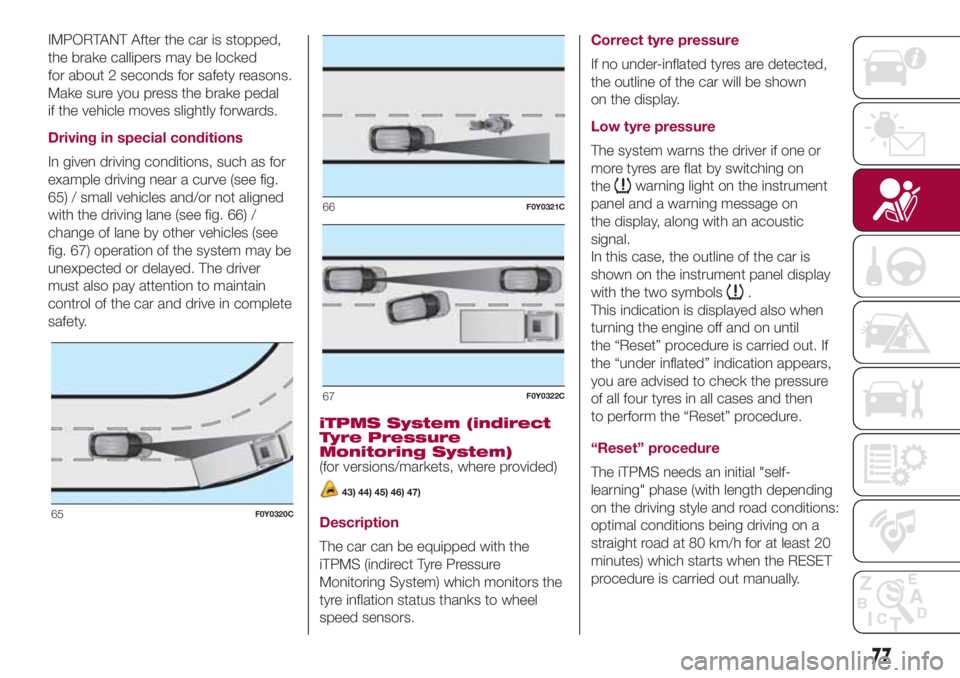
IMPORTANT After the car is stopped,
the brake callipers may be locked
for about 2 seconds for safety reasons.
Make sure you press the brake pedal
if the vehicle moves slightly forwards.
Driving in special conditions
In given driving conditions, such as for
example driving near a curve (see fig.
65) / small vehicles and/or not aligned
with the driving lane (see fig. 66) /
change of lane by other vehicles (see
fig. 67) operation of the system may be
unexpected or delayed. The driver
must also pay attention to maintain
control of the car and drive in complete
safety.
iTPMS System (indirect
Tyre Pressure
Monitoring System)
(for versions/markets, where provided)
43) 44) 45) 46) 47)
Description
The car can be equipped with the
iTPMS (indirect Tyre Pressure
Monitoring System) which monitors the
tyre inflation status thanks to wheel
speed sensors.Correct tyre pressure
If no under-inflated tyres are detected,
the outline of the car will be shown
on the display.
Low tyre pressure
The system warns the driver if one or
more tyres are flat by switching on
the
warning light on the instrument
panel and a warning message on
the display, along with an acoustic
signal.
In this case, the outline of the car is
shown on the instrument panel display
with the two symbols
.
This indication is displayed also when
turning the engine off and on until
the “Reset” procedure is carried out. If
the “under inflated” indication appears,
you are advised to check the pressure
of all four tyres in all cases and then
to perform the “Reset” procedure.
“Reset” procedure
The iTPMS needs an initial "self-
learning" phase (with length depending
on the driving style and road conditions:
optimal conditions being driving on a
straight road at 80 km/h for at least 20
minutes) which starts when the RESET
procedure is carried out manually.
65F0Y0320C
66F0Y0321C
67F0Y0322C
77
Page 80 of 268
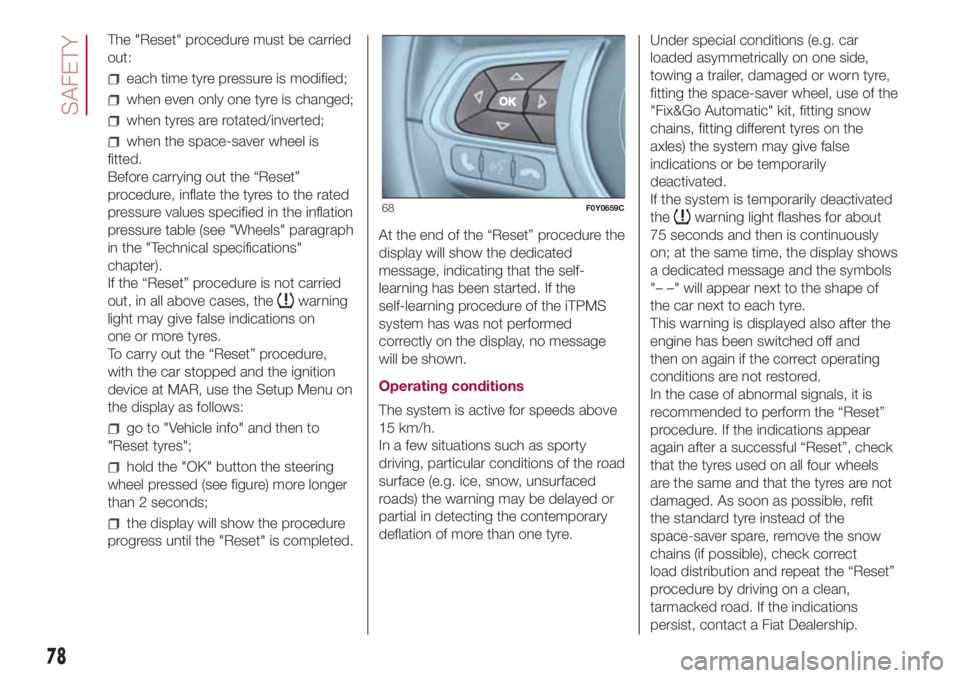
The "Reset" procedure must be carried
out:
each time tyre pressure is modified;
when even only one tyre is changed;
when tyres are rotated/inverted;
when the space-saver wheel is
fitted.
Before carrying out the “Reset”
procedure, inflate the tyres to the rated
pressure values specified in the inflation
pressure table (see "Wheels" paragraph
in the "Technical specifications"
chapter).
If the “Reset” procedure is not carried
out, in all above cases, the
warning
light may give false indications on
one or more tyres.
To carry out the “Reset” procedure,
with the car stopped and the ignition
device at MAR, use the Setup Menu on
the display as follows:
go to "Vehicle info" and then to
"Reset tyres";
hold the "OK" button the steering
wheel pressed (see figure) more longer
than 2 seconds;
the display will show the procedure
progress until the "Reset" is completed.At the end of the “Reset” procedure the
display will show the dedicated
message, indicating that the self-
learning has been started. If the
self-learning procedure of the iTPMS
system has was not performed
correctly on the display, no message
will be shown.
Operating conditions
The system is active for speeds above
15 km/h.
In a few situations such as sporty
driving, particular conditions of the road
surface (e.g. ice, snow, unsurfaced
roads) the warning may be delayed or
partial in detecting the contemporary
deflation of more than one tyre.Under special conditions (e.g. car
loaded asymmetrically on one side,
towing a trailer, damaged or worn tyre,
fitting the space-saver wheel, use of the
"Fix&Go Automatic" kit, fitting snow
chains, fitting different tyres on the
axles) the system may give false
indications or be temporarily
deactivated.
If the system is temporarily deactivated
the
warning light flashes for about
75 seconds and then is continuously
on; at the same time, the display shows
a dedicated message and the symbols
"– –" will appear next to the shape of
the car next to each tyre.
This warning is displayed also after the
engine has been switched off and
then on again if the correct operating
conditions are not restored.
In the case of abnormal signals, it is
recommended to perform the “Reset”
procedure. If the indications appear
again after a successful “Reset”, check
that the tyres used on all four wheels
are the same and that the tyres are not
damaged. As soon as possible, refit
the standard tyre instead of the
space-saver spare, remove the snow
chains (if possible), check correct
load distribution and repeat the “Reset”
procedure by driving on a clean,
tarmacked road. If the indications
persist, contact a Fiat Dealership.68F0Y0659C
78
SAFETY
Page 81 of 268
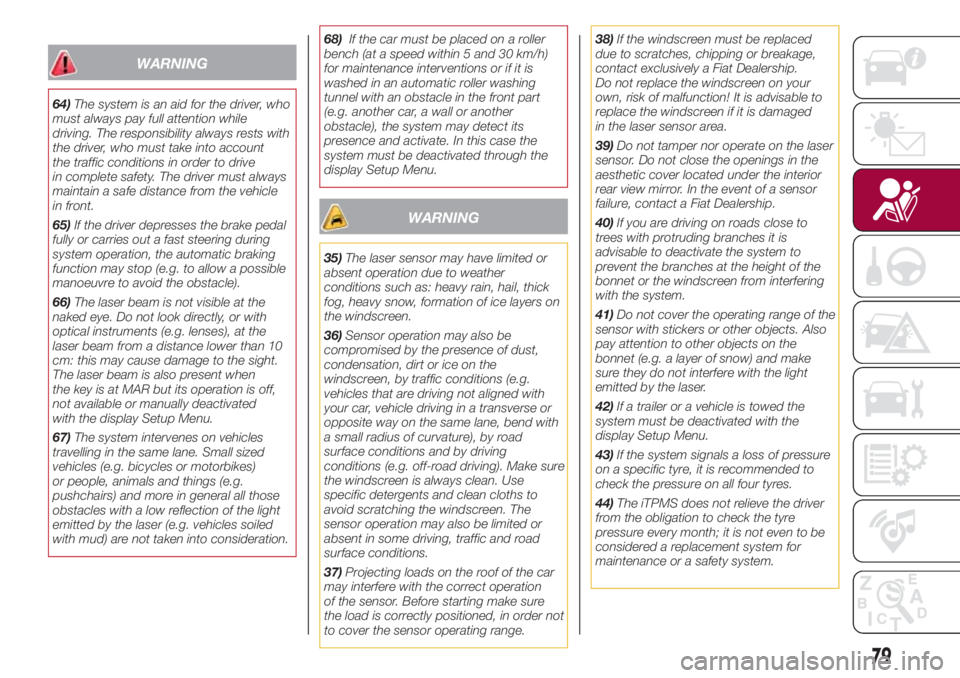
WARNING
64)The system is an aid for the driver, who
must always pay full attention while
driving. The responsibility always rests with
the driver, who must take into account
the traffic conditions in order to drive
in complete safety. The driver must always
maintain a safe distance from the vehicle
in front.
65)If the driver depresses the brake pedal
fully or carries out a fast steering during
system operation, the automatic braking
function may stop (e.g. to allow a possible
manoeuvre to avoid the obstacle).
66)The laser beam is not visible at the
naked eye. Do not look directly, or with
optical instruments (e.g. lenses), at the
laser beam from a distance lower than 10
cm: this may cause damage to the sight.
The laser beam is also present when
the key is at MAR but its operation is off,
not available or manually deactivated
with the display Setup Menu.
67)The system intervenes on vehicles
travelling in the same lane. Small sized
vehicles (e.g. bicycles or motorbikes)
or people, animals and things (e.g.
pushchairs) and more in general all those
obstacles with a low reflection of the light
emitted by the laser (e.g. vehicles soiled
with mud) are not taken into consideration.68)If the car must be placed on a roller
bench (at a speed within 5 and 30 km/h)
for maintenance interventions or if it is
washed in an automatic roller washing
tunnel with an obstacle in the front part
(e.g. another car, a wall or another
obstacle), the system may detect its
presence and activate. In this case the
system must be deactivated through the
display Setup Menu.
WARNING
35)The laser sensor may have limited or
absent operation due to weather
conditions such as: heavy rain, hail, thick
fog, heavy snow, formation of ice layers on
the windscreen.
36)Sensor operation may also be
compromised by the presence of dust,
condensation, dirt or ice on the
windscreen, by traffic conditions (e.g.
vehicles that are driving not aligned with
your car, vehicle driving in a transverse or
opposite way on the same lane, bend with
a small radius of curvature), by road
surface conditions and by driving
conditions (e.g. off-road driving). Make sure
the windscreen is always clean. Use
specific detergents and clean cloths to
avoid scratching the windscreen. The
sensor operation may also be limited or
absent in some driving, traffic and road
surface conditions.
37)Projecting loads on the roof of the car
may interfere with the correct operation
of the sensor. Before starting make sure
the load is correctly positioned, in order not
to cover the sensor operating range.38)If the windscreen must be replaced
due to scratches, chipping or breakage,
contact exclusively a Fiat Dealership.
Do not replace the windscreen on your
own, risk of malfunction! It is advisable to
replace the windscreen if it is damaged
in the laser sensor area.
39)Do not tamper nor operate on the laser
sensor. Do not close the openings in the
aesthetic cover located under the interior
rear view mirror. In the event of a sensor
failure, contact a Fiat Dealership.
40)If you are driving on roads close to
trees with protruding branches it is
advisable to deactivate the system to
prevent the branches at the height of the
bonnet or the windscreen from interfering
with the system.
41)Do not cover the operating range of the
sensor with stickers or other objects. Also
pay attention to other objects on the
bonnet (e.g. a layer of snow) and make
sure they do not interfere with the light
emitted by the laser.
42)If a trailer or a vehicle is towed the
system must be deactivated with the
display Setup Menu.
43)If the system signals a loss of pressure
on a specific tyre, it is recommended to
check the pressure on all four tyres.
44)The iTPMS does not relieve the driver
from the obligation to check the tyre
pressure every month; it is not even to be
considered a replacement system for
maintenance or a safety system.
79